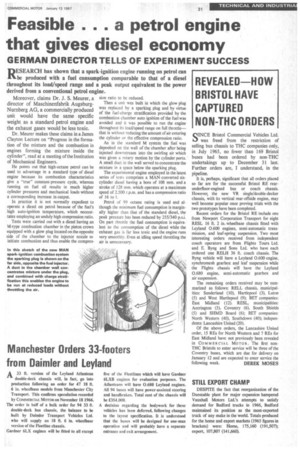Feasible . . . a petrol engine that gives diesel economy
Page 33

If you've noticed an error in this article please click here to report it so we can fix it.
GERMAN DIRECTOR TELLS OF EXPERIMENT SUCCESS
DESEARCH has shown that a spark-ignition engine running on petrol can be produced with a fuel consumption comparable to that of a diesel throughout its load/speed range and a peak output equivalent to the power derived from a conventional petrol engine.
Moreover, claims Dr. J. S. Meurer, a director of Maschinenfabrik AugsburgNurnberg AG, a commercially produced unit would have the same specific weight as a standard petrol engine and the exhaust gases would be less toxic.
Dr. Meurer makes these claims in a James Clayton Lecture on "Progress in the formation of the mixture and the combustion in engines forming the mixture inside the cylinder", read at a meeting of the Institution of Mechanical Engineers.
He points out that high-octane petrol can be used to advantage in a standard type of diesel engine because its combustion characteristics give a "true" constant-pressure cycle, whereas running on fuel oil results in much higher cylinder pressures and mechanical loads without a corresponding increase in output.
In practice it is not normally expedient to operate a diesel on petrol because of the fuel's high auto-ignition temperature, which necessitates employing an unduly high compression ratio.
Tests were carried out with a diesel having an M-type combustion chamber in the piston crown equipped with a glow plug located on the opposite side of the chamber to the injector nozzle to initiate combustion and thus enable the compres sion ratio to be reduced.
Then a unit was built in which the glow plug was replaced by a sparking plug and by virtue of the fuel-charge stratification provided by the combustion chamber auto ignition of the fuel was avoided and it was possible to run the engine throughout its load/speed range on full throttle— that is without reducing the amount of air entering the cylinder or the effective compression ratio.
As in the standard M system the fuel was deposited on the wall of the chamber after being injected downstream into the swirling air which was given a rotary motion by the cylinder ports. A small duct in the wall served to concentrate the mixture in a space below the sparking plug.
The experimental engine employed in the latest series of tests comprises a MAN-converted sixcylinder diesel having a bore of 108 mm. and a stroke of 128 mm. which operates at a maximum speed of 2.500 r.p.m. and has a compression ratio of 16 to 1.
Petrol of 99 octane rating is used and although the minimum fuel consumption is marginally higher than that of the standard diesel, the peak pressure has been reduced by 255/340 On part throttle the fuel consumption is equivalent to the consumption of the diesel while the exhaust gas is far less toxic and the engine runs very smoothly. Even at idling speed throttling the air is unnecessary.








































































































